- S&P 500 futures trigger limit down, before reversing
- OPEC-Texas production truce fades
- Indian stocks plunge over 11%, rupee falls to all-time low
- German Manufacturing PMI will be released on Tuesday; it's expected to show the EU's economic engine plunged deeper into contraction as data begins to reflect the impact of the virus.
- Oil traders are on alert for an update on U.S. crude oil inventories, published Wednesday.
- U.S Q4 GDP will be announced on Thursday.
- Futures on the S&P 500 Index decreased 3.3%.
- The Stoxx Europe 600 Index fell 4.3%.
- The MSCI Asia Pacific fell 2.9%.
- The dollar retreated 0.3% to 102.48.
- The euro rose 0.1% to $1.0701.
- The British pound decreased 0.2% to $1.1605.
- The Japanese yen increased 0.5% to 110.39 per dollar.
- The yield on 10-year Treasuries fell two basis points to 0.82%.
- Germany’s 10-year yield dipped four basis points to -0.37%.
- Britain’s 10-year yield decreased four basis points to 0.527%.
- West Texas Intermediate crude was little changed at $22.62 a barrel.
- Gold decreased 0.4% to $1,492.73 an ounce.
Key Events
U.S. futures for the S&P 500, Dow Jones and NASDAQ, along with Asian indices, started the trading week Monday by extending Friday's U.S. and global rout. India's BSE Sensex Index plunged, triggering halts in trade; shares closed down over 11%. The rupee hit an all-time low.
In the U.S., Congress's $1-trillion rescue package designed to provide aid to American workers and businesses impacted by the coronavirus stalled amid escalating Covid-19 fatalities.
Yields fell; oil fluctuated but ultimately pushed higher.
Global Financial Affairs
At the same time, the coronavirus continues to spread globally, currently topping 343,000 cases worldwide, with the fatality rate closing in on 15,000, according to Worldometer.
S&P 500 futures rebounded this morning from another 5% selloff, which hit the daily down limit, halting trading right after the open. Losses however were trimmed to under 4% and vacillating, until the contracts completely reversed course after the Fed announced, just moments ago, it would "begin backstopping an unprecedented range of credit for households, small businesses and major employers."
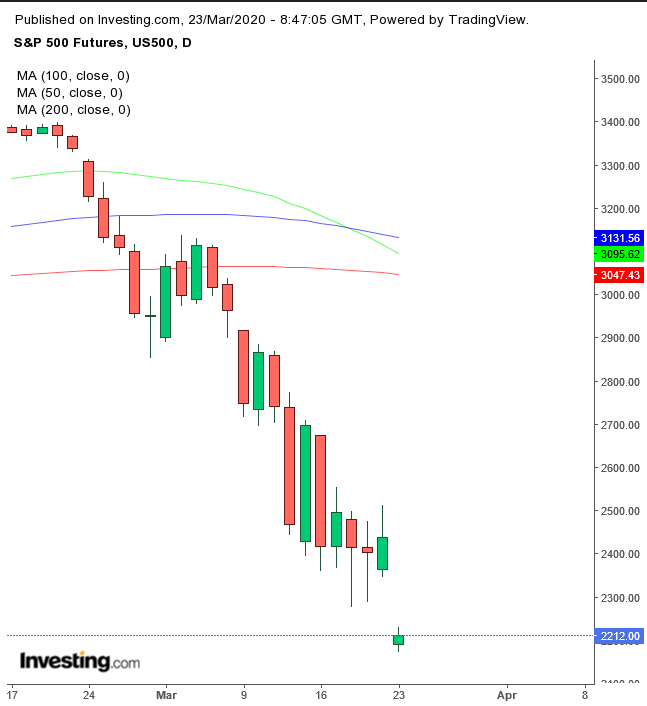
At today's open, futures opened lower, producing a falling gap, breaking the support of a range, along with Wednesday’s hammer. This is generally considered a signal that the underlying index will follow suit. However, any positive coronavirus news, such as the Fed's announcement, will likely flip the dynamics.
Healthcare stocks led the pan-European STOXX 600 Index into a decline. It had already opened sharply lower.
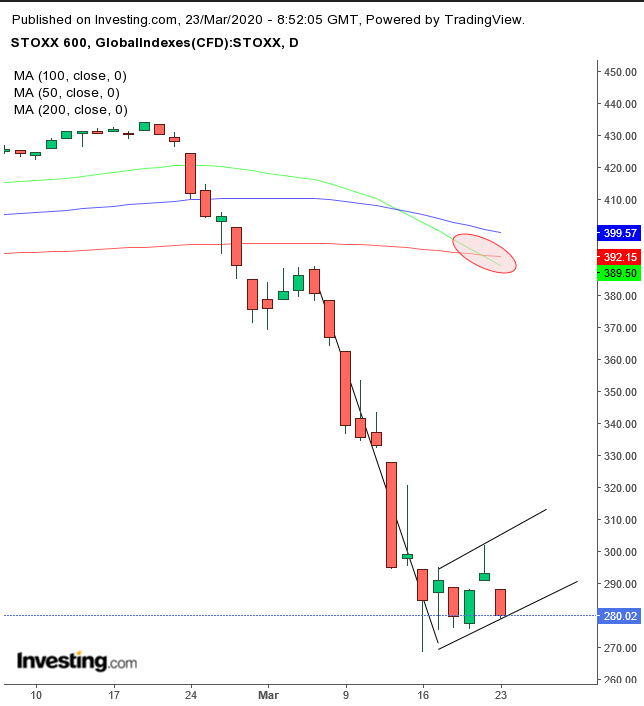
The price action’s position, however, was different than that of S&P 500 futures. While SPX futures saw a breakaway gap—when the price opened below the previous range, European shares started trade within the range. Therefore, in this case, the falling gap has no technical significance.
The price, however, found support at the bottom of a rising flag, bearish after the 30% free fall in only 8 sessions, from March 5-16. The 50 DMA crossed below the 200 DMA, suggesting this rising flag will complete with a downside breakout, signaling another leg lower.
Most stocks in Asia also extended their selloffs, except for Japan’s Nikkei, which soared 2.0%, after the International Olympic Committee said it only wants to delay, not cancel, the Tokyo Games. That momentary joy, though, is unlikely to have a lasting effect on the country’s equity market, which will probably follow other markets into a decline, as growing amounts of data reflecting the economic havoc caused by the virus begins to be released.
China’s Shanghai Composite continues to perform better than its neighbors, falling just 3.1% as compared to other regional indices that fell more than 5%. Both India’s main indices, the Nifty 50 and the Sensex crashed, each losing over 11%, with the national currency, the rupee, hitting the lowest level ever, as the Asian sub-continent heads into a nationwide lockdown.
The dollar edged lower, paring a two-day surge. Nonetheless, it maintained most of the advance as the Fed and other central banks cooperate to keep the global dollar flow intact, necessary for settlements, around the world.
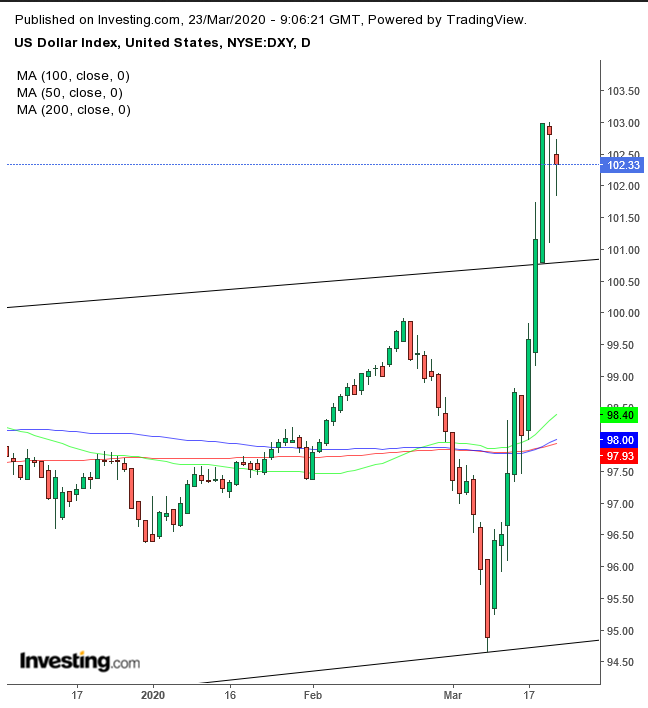
The Dollar Index opened lower but has been wavering. A close below Friday’s exceptionally powerful hammer would confirm a profit-taking decline, which would test the support of the top of a rising channel since the bottom of the February 2018 bottom.
Since President Donald Trump’s aggressive trade war with China and Europe, as well as his sanctions against Russia, there has been a move to reduce dollar dependency. It's the USD as the current global currency of settlement which gives the U.S. its negotiating power, rather than its military might. However, this once-in-a-century pandemic will likely undo reserve currency weightings by central banks, which would put the U.S. dollar back on the throne as the one, true FX king.
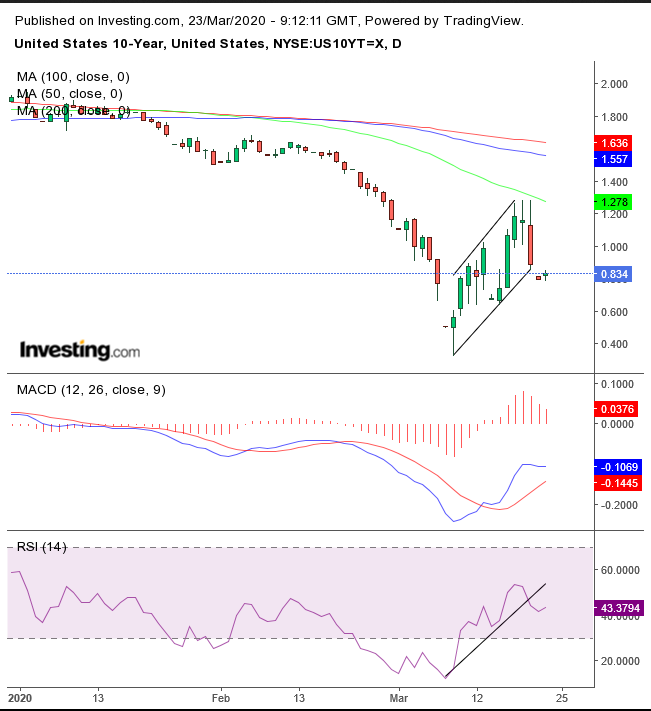
Yields for the 10-year Treasury note fell out of a rising flag, signaling another leg down. Both the MACD and RSI are displaying weakness.
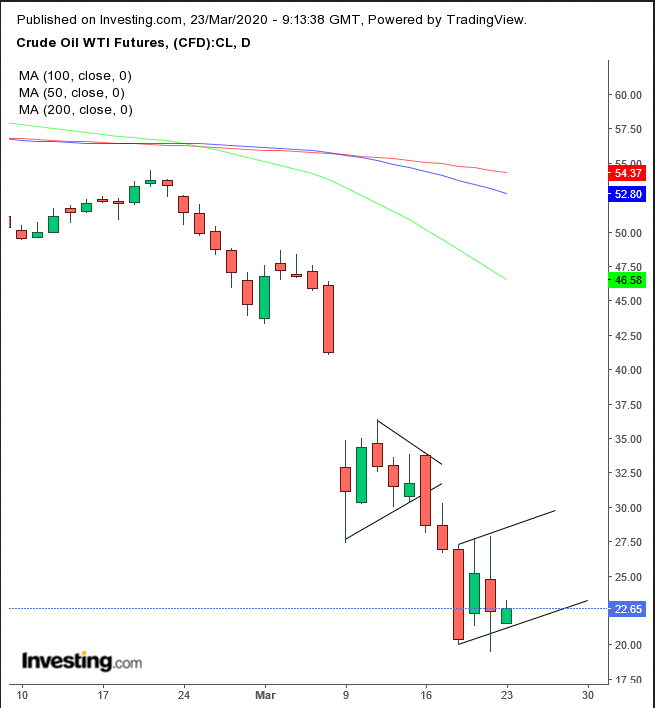
Oil seesawed, rebounding lower after hopes for an OPEC-Texas production truce faded. Technically, the price bounced off the support of a range, trading along a rising flag pattern, following the pennant. A return-move may take prices back to $30. However, the flag could provide a downside breakout, pushing prices below $20, for the first time since 2001.
